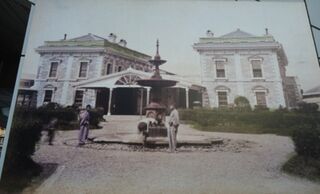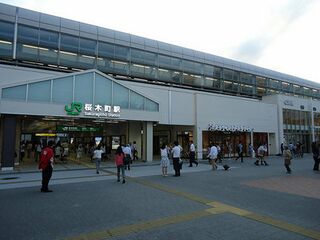Difference between revisions of "Sakuragicho Station"
(Created page with "*''Opened: 1872/5'' *''Japanese'': 桜木町駅 ''(Sakuragichou eki)'' Sakuragichô Station is a train station in Yokohama, which today serves as the gateway to the M...") |
|||
| (3 intermediate revisions by the same user not shown) | |||
| Line 1: | Line 1: | ||
| + | [[File:Sakuragicho1887.jpg|right|thumb|320px|Sakuragichô Station, then called Yokohama Station, as it appeared in [[1887]].]] | ||
| + | [[File:Sakuragicho-today.jpg|right|thumb|320px|Sakuragichô Station in September 2014]] | ||
*''Opened: [[1872]]/5'' | *''Opened: [[1872]]/5'' | ||
*''Japanese'': 桜木町駅 ''(Sakuragichou eki)'' | *''Japanese'': 桜木町駅 ''(Sakuragichou eki)'' | ||
| Line 4: | Line 6: | ||
Sakuragichô Station is a train station in [[Yokohama]], which today serves as the gateway to the Minato Mirai district. When it originally opened in [[1872]]/5, it was one terminus of Japan's first railroad line, connecting [[Tokyo]] (at [[Shinagawa]] Station) and Yokohama. | Sakuragichô Station is a train station in [[Yokohama]], which today serves as the gateway to the Minato Mirai district. When it originally opened in [[1872]]/5, it was one terminus of Japan's first railroad line, connecting [[Tokyo]] (at [[Shinagawa]] Station) and Yokohama. | ||
| − | Sakuragichô was "Yokohama Station" for 43 years, from its opening in 1872 until a new [[Yokohama Station]] was built in 1915 on the site which remains the main Yokohama Station today. | + | Sakuragichô was "Yokohama Station" for 43 years, from its opening in 1872 until a new [[Yokohama Station]] was built in 1915 on the site which remains the main Yokohama Station today. A cast-iron fountain originally erected in front of the station commemorated the first modern waterworks system. The fountain is preserved today at the Waterworks Memorial Museum (''Yokohama suidô kinenkan'') in Hodogaya. |
| + | |||
| + | A railroad spur was constructed in [[1911]] to connect the ''[[Akarenga soko|Akarenga sôko]]'' customs houses then being built at Yokohama's port, with Tokyo, via Yokohama (i.e. Sakuragichô). The terminus of this short line, at the customs houses, was renamed Yokohama Port Station (''Yokohama minato eki'') in 1920, and the line ran until 1986, when it was dismantled as part of extensive construction projects transforming the area into the new "Minato Mirai 21" district. A rail bridge from that port rail line (''rinkôsen'') can still be seen today in Minato Mirai, and a platform has recently been reconstructed just outside ''Akarenga sôko''. | ||
Various displays, signs, and markers at Sakuragichô today commemorate its history. | Various displays, signs, and markers at Sakuragichô today commemorate its history. | ||
Latest revision as of 01:28, 21 September 2015

- Opened: 1872/5
- Japanese: 桜木町駅 (Sakuragichou eki)
Sakuragichô Station is a train station in Yokohama, which today serves as the gateway to the Minato Mirai district. When it originally opened in 1872/5, it was one terminus of Japan's first railroad line, connecting Tokyo (at Shinagawa Station) and Yokohama.
Sakuragichô was "Yokohama Station" for 43 years, from its opening in 1872 until a new Yokohama Station was built in 1915 on the site which remains the main Yokohama Station today. A cast-iron fountain originally erected in front of the station commemorated the first modern waterworks system. The fountain is preserved today at the Waterworks Memorial Museum (Yokohama suidô kinenkan) in Hodogaya.
A railroad spur was constructed in 1911 to connect the Akarenga sôko customs houses then being built at Yokohama's port, with Tokyo, via Yokohama (i.e. Sakuragichô). The terminus of this short line, at the customs houses, was renamed Yokohama Port Station (Yokohama minato eki) in 1920, and the line ran until 1986, when it was dismantled as part of extensive construction projects transforming the area into the new "Minato Mirai 21" district. A rail bridge from that port rail line (rinkôsen) can still be seen today in Minato Mirai, and a platform has recently been reconstructed just outside Akarenga sôko.
Various displays, signs, and markers at Sakuragichô today commemorate its history.
References
- Plaques on-site at Sakuragichô.
